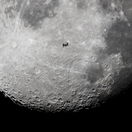A team of scientists has confirmed that there is a cave on the moon, not far from where American astronauts Neil Armstrong and Buzz Aldrin landed 55 years ago, that could serve as a base for building permanently habitable bases. In an article published in the journal Nature Astronomy, scientists simultaneously assume that there may be hundreds of such caves on the moon.
As reported by the AP, the Italian-led team announced that there is evidence of a large cave located near the Sea of Tranquility (Mare Tranquillitatis), just 400 kilometers from the Apollo 11 landing site.
Lunar seas do not contain water. They were formed approximately 3.9 to 3.2 billion years ago, when liquid lava filled the bottoms of giant basins on the Moon, which solidified over time. Seas are the only surface formation on the Moon that can be easily observed with the naked eye from Earth. The seas carry other traces of past volcanic activity: meandering furrows, small volcanic domes, cones and calderas.
The researchers analyzed radar measurements taken by NASA’s Lunar Reconnaissance Orbiter, which reveal only the initial part of the underground cavity. They estimate that it is at least 40 meters wide and tens of meters long.
Scientists assume that the cave was formed millions or even billions of years ago, when hot lava was moving on the moon – it could have made such a tunnel in the rock.
A similar phenomenon on Earth is the volcanic caves on the Spanish island of Lanzarote, says Professor Carrer. He added that Italian scientists visited this island as part of their research.
Carrer added that the authors of the study immediately realized that such a cave on the moon could be a good place for an astronaut base. “After all, life on Earth also began in caves, so people could live in them on the moon,” argued Carrer.
Caves would protect Earthlings from cosmic solar radiation as well as micrometeorite impacts. Building habitats from scratch would be more time-consuming, even when factoring in the potential need to reinforce the cave’s walls to possibly prevent its walls from collapsing, the scientific team said.
The rocks and other material inside these caves—unaltered by eons of harsh surface conditions—can also help scientists better understand how the Moon evolved, particularly in terms of its volcanic activity.

The cave that the scientists discovered has yet to be explored – it is believed that radar, cameras or even robots will be used for this. Scientists do not yet know the exact depth of this cave, nor the exact mechanism of their occurrence.
The south pole of our natural orbit also harbors permanently sun-shaded craters that could harbor water ice. It could serve as a source of drinking water and rocket fuel in the future.
“Moon caves have been a mystery for more than 50 years, so we’re excited to confirm the existence of one,” said Carrer and co-lead author Lorenzo Bruzzone of the University of Trento.
Source: vat.pravda.sk


